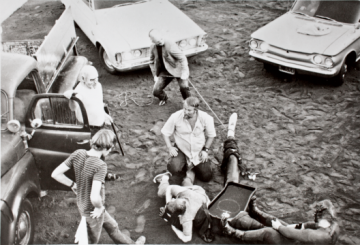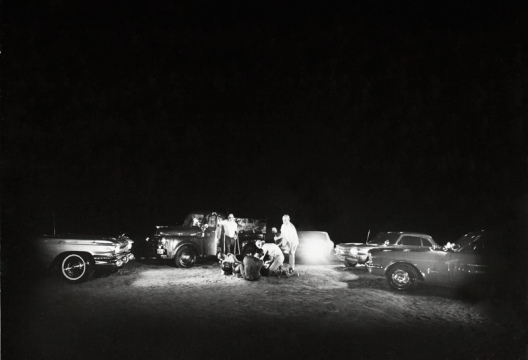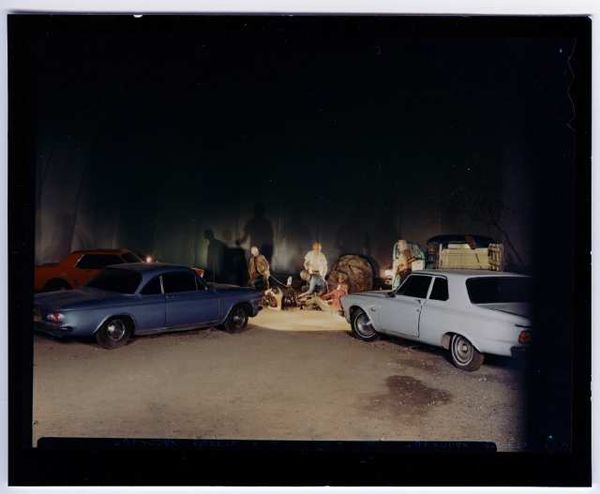
Kienholz and his team installing "Five Car Stud" in the parking lot of Gemini G.E.L. in Los Angeles. © Kienholz, photographs by John Romeyn, Bob Bucknam, Malcolm Lublinder, and Adam Avila, 1971.
“All the ghosts are assembling for the party.” That’s what Claire Danes says in the movie The Hours, when her mother, played by Meryl Streep, throws a dinner that brings artists and intellectuals bubbling up from the not-so-distant past. It’s also how art in Los Angeles feels right now. Pacific Standard Time (PST), a year-long, 10 million dollar Getty-funded initiative to probe L.A. art from 1945-80, just got underway. More than sixty cultural institutions are staging exhibitions, and the ghosts are assembling. Some of them, of course—like John Baldessari or Ed Ruscha—were never really gone. History’s kept them constantly at L.A.’s forefront. But even they have works that have rarely been seen and, perhaps, poorly documented. That’s PST’s goal: to preserve parts of SoCal art history that seemed about to fall through the cracks.

Edward Kienholz, "Five Car Stud," 1969–72. © Kienholz. Collection of Kawamura Memorial Museum of Art, Sakura, Japan. Courtesy of L.A. Louver, Venice, CA and The Pace Gallery, New York.
One exhibition that opened at Los Angeles County Museum of Art (LACMA) two weeks ago features a work that did fall through the cracks. It’s an installation by assemblage king Ed Kienholz, the artist who co-founded the now-iconic Ferus Gallery and had an infamous inability to keep his indignation in check (once, he took an axe to an airline desk after baggage handlers broke his Tiffany lamp). This work, made between 1969-72, never showed in L.A. LACMA curator Maurice Tuchman did his best to get it on display, but Kienholz had caused enough trouble with his 1966 retrospective, which was almost shut down due to the sculpted copulating couple in the installation Back Seat Dodge. The museum didn’t give him another chance to provoke.
Instead, the work was exhibited at Documenta 5 in Kassel, Germany, then traveled to Dusseldorf and Berlin before being bought by a collector. Now, finally, the work is on view in the city where it was made. Called Five Car Stud, the dark, unapologetically explicit installation depicts a black man about to be castrated by five garishly masked white men–a sixth stands by. Apparently the victim slept with the crying woman in a nearby truck. There’s a lot to say about Kienholz’s tableau. First, there’s the title, which sounds like it could be the name of B-grade racing movie, full of badasses in fast cars. Then there are the figures, which look like a mix between the art of George Segal and David Lynch—life-sized and all-American, but hellishly creepy. On LACMA’s website and in the foyer in front of the exhibition, you can see photos of Kienholz casting the bodies of friends and acquaintances so that the villains in “Five Car” would be true to life. You can also see him setting up in the parking lot of the print workshop Gemini G.E.L., piecing together what would be the black man’s body. The whole process looks like fun, and the making-of images make it easy to forget Kienholz’s content.

Kienholz's "Five Car Stud." Collection of Kawamura Memorial DIC Museum of Art, Sakura, Japan. Courtesy of L.A. Louver, Venice, CA, and the Pace Gallery, New York
When the piece was exhibited at Documenta 5, it appeared inside a black blow-up tent. At LACMA, it is shown inside an all-dark room with deep sand spread across the floor and faux flora and fauna to make the scene look quaintly rural. The headlights of the five cars the men came in all point toward the action at the center.
Kienholz bought the plastic masks his figures wear at a Hollywood costume shop. Wherever he bought the tub that stands in for the black man’s torso, or the colored letters that float in the tub and spell the word “Nigger,” depriving the man of a torso makes him feel flat, less dimensional than his attackers.
“Generally I think of Five Car Stud as symbolic of minority strivings in the world today,” Kienholz reportedly wrote at the time. If so, he was preaching to the choir. A Documenta audience wouldn’t have needed to see a castration spelled out to know it was abominable, nor would a LACMA audience. On the whole, the installation feels like theater for theater’s sake.
So far, all the press has been positive. The work is “powerful,“ “alarming,” still “a provocative commentary on the fear, anger and pain created by intolerance.” “I was shocked,” said critic Hunter Drohojowska-Philp on public radio, “and the LACMA guards, who are mostly black, looked pretty stunned as well.”
“He’s a Cotton Mather,” said Kienholz’s peer Bruce Conner, interviewed in 1974. He’s “there to exploit the situation, not to correct it,” and that seems closer to the truth. Five Car Stud is melodrama and provocation, no real consciousness. Still, it’s among the most interesting things I’ve seen at this early point in PST, because it shows history as the baggage-rife mess that it is. The ghosts are assembling, and they’re bringing all their faults and failures with them.




Pingback: Money/Market | Art21 Blog